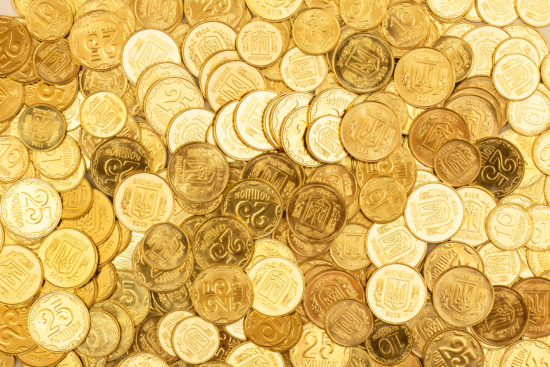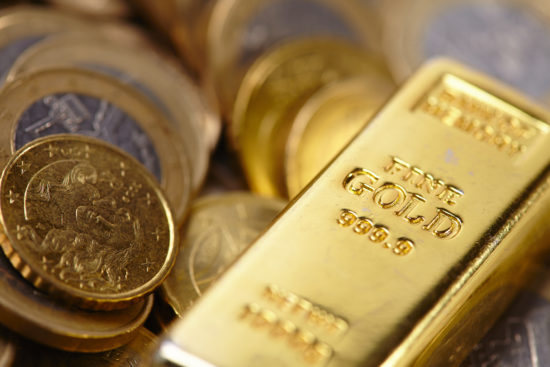There is something funny about the way our monetary system works right now that many people either don’t think about or they take for granted. That is the fact that money, the coveted dollar bill, isn’t actually worth anything. It is a product of something called the fiat system which is currently used the world over. Fiat, meaning a formal authorization or proposition as well as an arbitrary order, is used hand in hand with the dollar. Basically, the dollar only has value because governments like the United States tells us it does, that’s it!
Consider this, put a dollar bill in your left hand and a very small piece of gold or silver in your right. That dollar has value by way of government decree. You can rip it, burn it, or throw it away and the government can just print more. What’s more, the exact worth of that paper dollar is determined by public sentiment and the relative value of other currencies around the world all of which are based on fiat systems too. Not very stable right? Now, consider gold or silver. It is difficult to destroy, it is difficult to dig up, and there is a limited global supply. It is real and it is valuable. And unlike the dollar bill, it is impossible to artificially create. That is why so many people secure their wealth in gold or silver.
The Classic Gold Bar
For much of human history, gold played its part to convey wealth, status, and reverence. Its luster, malleability, density, and rarity gave it an intrinsic value that instantly made it the metal of kings and religious institutions. Gold has been shaped into everything from crosses and busts of pharaohs to coins and small pieces of jewelry. One of it’s most iconic forms though is the gold bar. You can picture it stacked in vaults or being pilfered by outlaws in an old western.
This classic gold bullion is still in use today and is held in gold reserves by central banks the world over. The United States apparently holds over 147 million ounces of gold bricks with a total value of around $250 billion in the infamous and well-fortified United States Bullion Depository, better known as Fort Knox. Each typical standard gold bar weighs in as a 400-troy-ounce Good Delivery gold bar which actually weighs 27.4 lbs (12.4 kg or 438.9 ounces). A little arithmetic tells us that Fort Knox houses some 335,611 individual gold bricks give or take a couple hundred.
When discussing classic gold bar weight it is important to understand two standards by which quality is measured: troy ounces and Good Delivery. Troy weight is a system of units of mass that originated in 15th-century England and is used primarily with precious metals. The specifics of the system can get a little funny with measurements in grain and pennyweight and such but the most important thing to note is that 1 troy ounce is equal to 1.097 regular ounces or 31.1 grams. When you are discussing gold it can be assumed that you are referencing troy ounces sometimes and some people will just say ounce when they mean troy ounce.
These classic gold bars are also subject to Good Delivery specifications as set out by the London Bullion Market Association (LBMA). These basic specifications for gold bars include a minimum fineness of 995.0 parts per thousand fine gold, marks including a serial number, refiner’s hallmark, fineness, and the year of manufacture, a gold content of around 350–430 troy ounces (11–13 kg) and length, width, height requirements. The LMBA sets out similar specifications for silver bars as well.
This system is what works for large banks and national governments because they are the ones mostly dealing in such large quantities of gold. At the time of writing the price of gold stood around $1700 which would make one 438.9 oz classic bar of gold worth about $750,000. For smaller businesses and individuals dealing in gold, it is less common to have this much precious metal. Instead, there are other sizes of gold bars to be considered.
The Other Gold Bars
The Good Delivery gold bar is a hefty and expensive piece of gold and it is also a bit unwieldy. Sure it stacks well enough, but the size and value of the bar limit its uses for trade and investment. This is where the smaller kilobar came into existence. As the name implies this is a 1000 gram or 32.15-oz bar of gold. It often appears as a relatively flat bar, almost shaped like a chocolate bar.
Keep in mind this bar is still worth quite a lot and would clock in at over $50,000 in the current market. Still, the size, portability, and lower price tag per bar have made this the bar of choice for some banks, businesses, and investment firms. 10,100, and 1000-gram bars are also preferred in Asian markets as opposed to troy-ounce measurements. Europe makes use of the kilobar as well but there you are more likely to find it molded into the classic brick shape instead of the flat chocolate bar shape.
Gold’s consistent value and malleability have led to the rise of many different sizes, weights, and shapes for gold bars. Still among those in international business, there has been an effort to maintain a standard. A Good Delivery bar means one thing, a kilobar another. This allows certain types of trade and commerce to occur with a common understanding of exactly what is on the table.
Smaller ten ounce and one troy ounce bars are produced commonly for smaller trades, investments, and transactions. Gold coins are also produced and these are an especially useful investment vehicle for individuals. This is the size range that many individuals should consider for their own investments and financial security. History has proven that banks aren’t infallible especially considering the implications of the fiat system. That isn’t to say you should pull all of your money out of the market and the banks and convert it to gold but having a physical gold holding should be a part of your investment and financial security strategy.

The Largest Gold Bar
While some gold bars are made smaller and lighter to accommodate value and portability other bars try to pack as much gold in as possible. One bar, in particular, holds the record for being the largest gold bar in existence. Typically bars don’t exceed the Good Delivery standard but the bar produced by the Mitsubishi Materials Corporation, a subsidiary of Mitsubishi, could be made into several Good Delivery bars.
This record-setting bar weighs in at 250 kg (551 lb), measuring at the base 455 mm × 225 mm (17.9 in × 8.9 in) and 170 mm (6.7 in) high with a 5-degree draft angle. This bar is big and can be seen on display at the Toi Gold Museum in the city of Izu, Shizuoka, Japan. The gold content alone was valued in 2005 at approximately $3,684,000 and as of 6 May 2019, it is worth approximately US$10.325M.
It’s Not Just about Weight
Imagine you inherit a 5-ounce bar of gold. You hold it in your hand, admire its beauty, and even think to yourself how it is heavier than you thought it would be for its size. You hold on to the bar for a few years and eventually decide to sell it. However, when you take it into the gold buyers they have some bad news for you. Your bar isn’t actually gold. So, now what?
Although the value of gold is often recorded in ounces you need to consider more than just the weight of the gold in question. It isn’t unheard of for people to take other substances and coat them in gold or color them gold through other processes. Sometimes the fakes can be hard to spot. Thankfully there are a few techniques you can employ to reduce the risk of your gold being fake.
The first tests you can try are the magnet test and the ceramic test. Unlike other metals gold is not magnetic so sticking a fairly strong magnet against your gold sample should have no effect if in fact it really is gold. The other test is the ceramic test in which you lightly scrape your gold over an unglazed ceramic plate. If you see a gold mark on the ceramic plate then your gold is real but if you see a dark mark then it is fake. These two tests are just a couple of the more common at home gold tests you can try.
Gold can also be verified by the security features employed by the manufacturers of cast and minted bars. Most commonly these manufacturers will brand bars with a serial number and provide a certificate of authenticity. For the relatively cheaper and more imperfect cast bars, this is sometimes as far as security measures go. Minted bars, on the other hand, are often sealed in protective packaging to prevent handling and damage. Some of these packages include unique holographic features that identify them as being legitimate.
Gold Purity is Key
Five oz gold bars made of 10 karat gold are much less valuable than five oz gold bars made of 24 karat gold. That is because a karat is a measurement of the ratio of gold to other metals or alloys ranging from 0 to 24K. A 10K piece of gold has 417 parts-per-thousand of gold (41.7%) while a 24K piece has 999 parts-per-thousand of pure gold (99%). Just as you need to check the authenticity of your gold you must also check the purity. If you can verify the authenticity then the purity is almost always correct and should be labeled on the gold piece somewhere.
If however the purity isn’t listed on the piece you should take the time to determine what it is. Any gold professional should be able to test your gold for you and tell you what it is worth but, if you are so inclined, you can also test the purity at home using a testing kit. These kits take advantage of a unique property of gold.
Normally gold is unreactive with acids, that is unless you mix nitric and hydrochloric acids to create a unique solution called aqua regia. This liquid comes in testing kits and can be used to test the purity of gold. Lower karat golds will contain more alloys and other metals that will be especially reactive to the liquid as well. Using a solution of nitric acid along with aqua regia and other tools you will be able to determine the exact purity of a gold sample.

Is Gold a Commodity or a Currency?
We discuss the weight, size, and limited availability of gold because it is a real and minable precious metal. In that sense, it is like a commodity. On the other hand, we use gold as a currency and discuss its value as such. It even tracks like a currency but with the added benefit of still being like a commodity. In a way, gold is a commodity that behaves like money. The essential question of whether gold is a commodity or currency leads to a discussion of how and why we value gold the way we do. Gold is better considered as a type of commodity money.
It has historical precedence as currency, is currently evaluated in that way, yet still displays core traits of a commodity. We’ve discussed how currency is based in the fiat system and its only real value is determined by decree of the government. If they need to print more they do. Gold, on the other hand, according to one analysis is, “a tangible asset, so it cannot be printed like fiat currencies. Thanks to its relatively inelastic supply, gold preserves its purchasing power, thus serving as a hedge against governments’ madness and as a safe haven during financial turmoil,” it is, “an anti-fiat currency, bought when the trust in central banks and governments diminishes.”
The truth is unless we start mining other planets or drastically improve chemical manufacturing processes there is a limited supply of gold on Earth. That supply is constantly traded in a large, decentralized, liquid market. Yet still, if all that were to collapse, gold maintains an intrinsic value. Its beauty, malleability and long history of association with kings and rulers has secured its position in popular thought as a precious metal of high value.
What Current System Determines the Value of Gold?
Despite the intrinsic value of gold, it is bought, sold and traded with a price tag based in the United State’s fiat currency. Historically the process that led to this price was controlled by five companies that ran the London Gold Market Fixing Company and set prices by phone. That black box of a system was taken over on March 20, 2015, by the ICE Benchmark Administration (IBA). They replaced the process with an electronic auction system called the LBMA Gold Price.
That is the same LBMA that sets the Good Delivery standards for larger gold bricks. They actually own the rights to this process of price setting while several banks, an oversight committee, and a panel of internal and external chair members make up the IBA itself. At 10:30 AM and 3:00 PM, UK Time the IBA publishes the LBMA Gold Price in US dollars based on financial evaluations of anonymous auction rounds run every 45 seconds. The price is then fixed when all buy and sell orders and imbalances are within 20,000 troy ounces.
This pricing process is really just based on the gold futures and spot prices though and those are determined by larger-scale factors. The supply and demand for gold, overall market conditions, and relative currency depreciation all play a major role in the final price point of gold. This sets the extrinsic value of gold for a global market and makes gold a good counterbalance for the volatility of fiat currencies.
Final Verdict:
As a form of commodity money, gold is the best safeguard against the tenuous value of the unbacked dollar. It carries both intrinsic and extrinsic value which has a proven track record of nicely counterbalancing the inevitable inflation in fiat currencies. It is relatively stable because, unlike money, it can’t be printed and produced at will. There is a set quantity in the market and, more importantly, a set quantity on the planet.
Although large Good Delivery bricks like those held in Fort Knox are usually outside of the investment range of most individuals there are plenty of other options available. You can buy gold directly and hold on to it, you can invest in gold through the markets, and you can even speculate on the means of production. Gold, as an investment vehicle, is something that should be part of everyone’s wealth management strategy.

